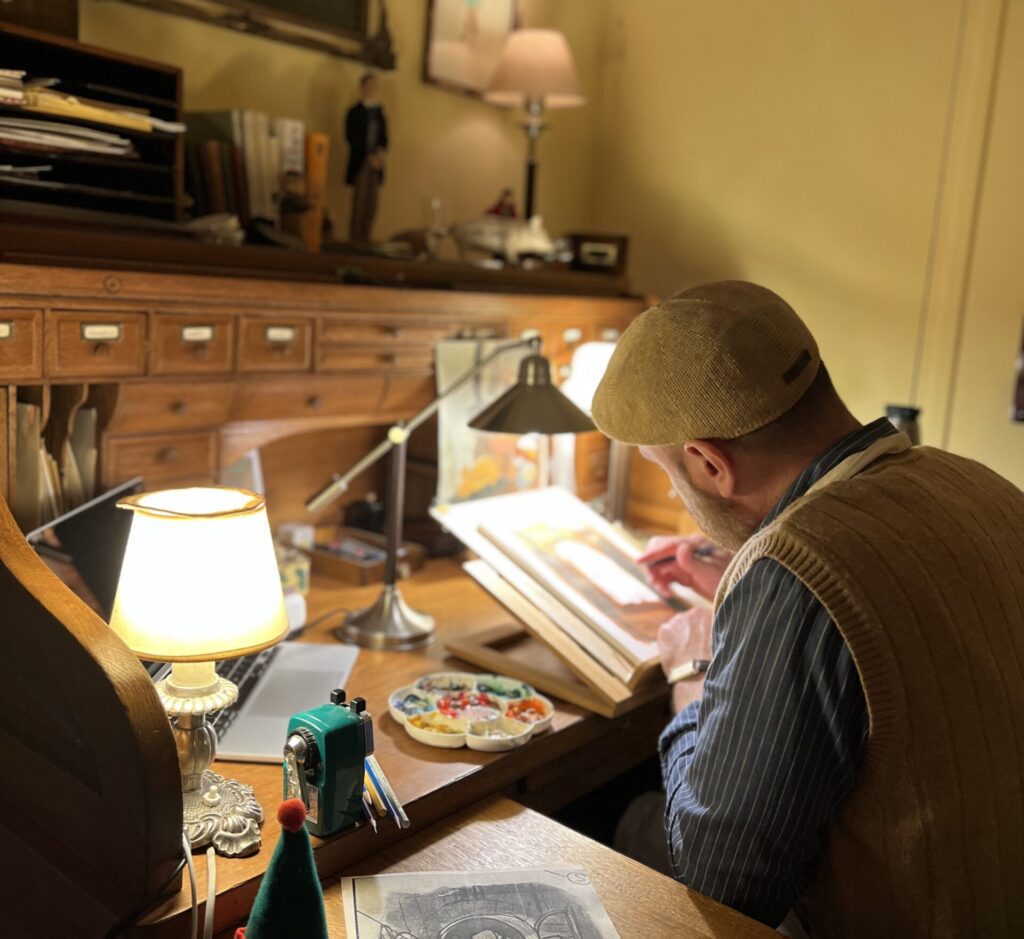
Guillermo Decurgez, conocido como Decur, nació en Rosario, Argentina en 1981. Es Historietista e ilustrador de fuerte carácter autodidacta, fue albañil y operario de una fábrica donde, diariamente, colocaba ciento cuarenta puertas de auto por día. Logró cambiar ese mundo gris por otro pleno de colores y, tras una fuerte depresión, resignificó la palabra cajón: «Mi cuerpo está lleno de pequeños cajones; hay cajones con luces de colores y otros con tan solo la llama de una vela. Hay uno en especial que representa mi infancia; adentro hay un gran árbol adornado por una pequeña casa y, en ella, un niño que me invita a jugar». En efecto, para Decur la infancia es un territorio sagrado. Cuando era chico no paraba de dibujar: influenciado por el trabajo de Quino, Caloi, Fontanarrosa, Liniers y Jorge González, entre otros, relata: «Iba al dentista y agarraba las revistas, encontraba una ilustración de Quino, tosía y al mismo tiempo arrancaba la hoja. Por entonces no tenía más de ocho años».
Publicó los libros Merci! (2011), ¡Pipí cucú! (2013) y Semillas 1 (2015), todos en Ediciones de la Flor; y Mi cajón favorito (2014), en editorial Thule. Con la Editorial Zorro Rojo ha realizado la primera edición ilustrada en America Latina de “Ivan el tonto” de Tolstoy (2019). Ha ilustrado “El crimen casi perfecto” de Roberto Artl con la editorial Ojoreja (2019). Ha exhibido sus ilustraciones en Francia, España, Chile, Bolivia, Colombia, Argentina y Estados Unidos.
Los libros de quien confiesa buscar «una belleza imperfecta inspirada en las plantas, los escritorios antiguos y los animales» ya circulan por todo el mundo. Su última novela “Cuando levantas la mirada” (2020) editada por Enchanted Lion Books, fue reconocida por el New York Times como uno de los mejores 25 libros del año 2020, nominada a dos premios Eisner por mejor pintor y mejor edición, y ha ganado la medalla de oro de Arte Original en la Sociedad de ilustradores de Nueva York. Traducida al español, inglés, coreano, lituano, francés y chino.
Actualmente vive y trabaja en Arroyo Seco, en la casa que le legó su abuelo, acompañado de su mujer Celeste, un perro chihuahua y una perra muy peluda. Tiene tres escritorios antiguos que le sirven como puertas dimensionales.
Guillermo Decurgez, known as Decur, was born in Rosario, Argentina in 1981. He is a cartoonist and illustrator with a strong self-taught character, he was a mason and operator of a factory where, daily, he placed one hundred and forty car doors per day. He managed to change that gray world for another full of colors and, after a strong depression, resignified the word drawer: “My body is full of small drawers; there are drawers with colored lights and others with just the flame of a candle. There is one in particular that represents my childhood; inside there is a large tree adorned by a small house and, in it, a child who invites me to play.” In fact, for Decur childhood is a sacred territory. When I was a boy he did not stop drawing: influenced by the work of Quino, Caloi, Fontanarrosa, Liniers and Jorge González, among others, he relates: “I went to the dentist and grabbed the magazines, found an illustration of Quino, coughed and at the same time tear off the leaf. At that time I was no more than eight years old.”
He published the books Merci! (2011), Pipí cucú! (2013) and Semillas 1 (2015), all in Ediciones de la Flor; and Mi cajón favorito (2014), in Thule publishing house. With Editorial Zorro Rojo, he has made the first illustrated edition in Latin America of “Ivan el tonto” by Tolstoy (2019). He has illustrated Roberto Artl’s “The almost perfect crime” with the Ojoreja publishing house (2019). He has exhibited his illustrations in France, Spain, Chile, Bolivia, Colombia, Argentina and the United States.
The books of those who confess to looking for “an imperfect beauty inspired by plants, antique desks and animals” are already circulating all over the world. His latest novel “When you look up” (2020), edited by Enchanted Lion Books, was recognized by the New York Times as one of the best 25 books of the year 2020, nominated for two Eisner awards for best painter and best edition, and he has won the gold medal in Original Art at the Society of Illustrators of New York. Translated into Spanish, English, Korean, Lithuanian, French and Chinese.
He currently lives and works in Arroyo Seco, in the house bequeathed to him by his grandfather, accompanied by his wife Celeste, a Chihuahua dog and a very hairy dog. It has three antique desks that serve as dimensional doors.

